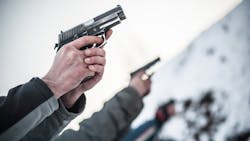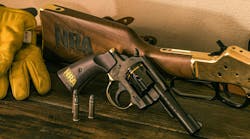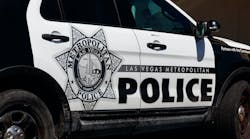During some recent time at the range, I overheard an instructor explaining to the officers why the qualification standards are what they are. In that state, there is a State Training Commission that sets the minimum standards for police / deputies and correctional officers to meet to be certified. Certification by the training commission is required to hold those positions. The minimum standards aren't all that difficult to attain for the average officer, although there are those who consider it a challenge. Since we're discussing firearms qualifications, let's take a quick look at the minimum standards set.
First, the commission has mandates that the Course of Fire must meet. Those mandates regard number of shots fired from each distance, the minimum number of rounds that must be fired total, time permitted per shot at each distance, time permitted for a reload drill, and how many rounds of the course must be fired with the weak hand. (Author’s Note: Based on my background as a firearms instructor, I believe those minimums to be very generous in time and the number of shots fired weak hand to be of minimal concern.)
The maximum required qualification distance for a handgun is twenty-five (25) yards, and with any contemporary duty handgun that's not a problem either. The final requirement set by the commission is a minimum score of 70%. Using standard B27 targets, and the NRA scoring system that is printed in the upper left corner, 70% reflects 175 points (out of 250) on a fifty-round course of fire, or 210 points (out of 300) on a sixty-round course of fire. The agency observed that particular day has a sixty-round course of fire. Each police officer / deputy in Maryland is required to qualify once each year on a day course of fire, on a low-light course of fire and on a judgmental course of fire.
Last year the agency in question had requirements that exceeded the commission requirements because their General Orders mandated a 75% minimum score. The course of fire is approved by the training commission. However, the commands given and the structure of how the course was run was something that needed to be upgraded. As examples, no "moving to cover" was included in the course; every line of fire started with the words, "when your target turns;" the shooters were told exactly when reloading would be required. You get the idea: it was a nice, comfortable, minimum stress, easily managed course of fire. Time to step up a little bit.
As the Day Course of Fire was updated, input from the officers was gathered. The agency also looked around at neighboring agencies to get a feel for what they were doing. The command structure for running the course is now much better and the demand of performance on the shooters is higher. Examples: Every line of fire now starts with, "When a threat presents itself;" numerous lines of fire require the officer to seek cover before engaging the target; reloads are not prompted; and one phase of the qualification is a string of moving / shooting to engage a target from three different firing points / positions while steadily closing distance. The officers found it more challenging and really enjoyed it.
Then the negative comments began. They're still using B27 targets and the NRA scoring system. However, they have added a requirement that every shot fired must be on the silhouette. While several officers on the agency can shoot better than 90% every course, they inevitably have only 57 or 58 shots on the target because they've missed the other ones shooting weak hand from the twenty-five-yard line. Under the new qualification requirements, a 98% with 58 holes (out of 60 shots) was not qualifying. Because of that, there were some unhappy campers. What was the reasoning for changing the requirement they wanted to know?
It was explained to them as if they were arguing with administrators and lawyers. Why do they have the requirements they have? Each was individually examined, explained and justified.
The score and hit count are two completely objective measures of an officer's performance in basic marksmanship. At distances out to twenty-five yards, with generous time limits (three seconds per shot at the fifteen-yard line is an example) mandated, there's no excuse for an officer not to have that minimum 75% score and all sixty rounds on target. That was the most questioned requirement: how come, suddenly, the agency is requiring sixty holes in the target? Because every hole not in the target represents an unintentionally shot innocent bystander / victim down the road.
For years, the FBI's annual report has told us that officers nationwide only average about a 20% hit ratio in actual shootings. Could that be, in part, due to the fact that we don't make them responsible for every round on the range. Having given it some consideration the training commander was envisioning the lawyer for the plaintiff, pacing in front of him as he sat in the witness box, and could hear his question: "So, Lieutenant, your qualifications course allowed officers to miss the target without penalty?" "Lieutenant, according to your course of fire, it's acceptable for officers to completely miss the target as much as eighteen times out of sixty shots?" That just looked ugly.
On to the other changes: Having officers move to cover before engaging a target. Duh. Standing out in the open while rounds are incoming is just dumb… but we firearms instructors taught officers to do exactly that for years upon years because we never taught them to do anything else.
Having the officers reload as necessary instead of when prompted. Well, no one is going to be telling them when they're going to need to reload in a shooting, so why prompt them on the range? Let's put the responsibility for round count and "topping off" back on them.
Having them run, take cover, engage the target, move, take cover, engage the target, and so on. Well, the agency observed borders Washington DC and the reality of life is that the officers may very well end up in a running gun battle: yard to yard, house to house, garage to garage, shed to fence, etc. They may well find themselves firing a couple rounds and then having to continue a pursuit before engaging again. Oh, and they'll have to reload as necessary and clear malfunctions if they arise.
That's one thing this particular agency has been good about for years. When most of the officers went through the academy, they were taught to raise their hand if they encountered a malfunction (gives away the average age of the officers). Instead, these officers now are told that if they experience a malfunction on my range, seek cover (or kneel) clear it and get their rounds off. The firearms instructors will wave time limits as long as the officer stays in the fight. The only malfunction they will "alibi" is a double-feed and they only alibi that if there are other shooters on the line. If they have a single shooter, he'll work through that too.
The agency has also recently approved edited General Orders that permit backup / secondary handguns. The primary firearms instructor already planned the course of fire for those weapons as well. Not only is there a requirement for the officers to complete an entire qualification course with the backup handgun but is also a course that requires him (or her) to transition from primary to secondary weapon based on ammo count or malfunction.
The only thing they don't currently incorporate that they’d like to have is some steel. On the range they use, regulations prohibit the use of steel targets unless they use frangible ammunition. Cost is the inhibiting factor there, but they're working on it. As soon as they can include it, the move-and-shoot portion of the qualification course will use a steel 12" x 18" target instead of a B27 paper target. Every DING will count as five points. What misses count for is obvious: potential liability suits in the officer's future.



